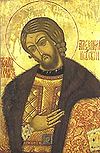- Nora Gal
-
Nora Gal (Russian: Нора Галь), full name Eleonora Yakovlevna Galperina (Russian: Элеонора Яковлевна Гальперина, b. April 27, 1912, Odessa — d. July 23, 1991) was a Soviet translator, literary critic, and translation theorist.
She was born on April 27, 1912 in Odessa. Her father was a medical doctor. As a child, she moved to Moscow with her family. After several unsuccessful attempts she was admitted to the Lenin Pedagogical Institute, from which she graduated. She then completed her post-graduate studies with a thesis on the French poet Arthur Rimbaud and published articles on classical and contemporary foreign literature (Guy de Maupassant, Byron, Alfred de Musset). She married literary critic Boris Kuzmin and later became editor of his selected works.
When she was still a schoolgirl she published some poems, while during her student years she switched to prose. Towards the end of the 1930s, she wrote many articles on contemporary foreign literature. She started her active career as a translator during World War II, and after the war she devoted herself to translating authors such as Jules Renard, Alexandre Dumas, père and H. G. Wells.
In the 1950s, she translated "Le Petit Prince" by Antoine de Saint-Exupéry, novels by J.D. Salinger, and "To Kill a Mockingbird" by Harper Lee into Russian. She became a widely respected and prominent translator. In the last period of her activity she tackled such masterpieces as " The Stranger" by Albert Camus and "Death of a Hero" by Richard Aldington, as well as books by Thomas Wolfe, Katherine Anne Porter, and by a number of science fiction authors, including Isaac Asimov and Arthur C. Clarke, Roger Zelazny and Ursula K. Le Guin.
In 1973 she wrote Words Living and Words Dead (Слово живое и мёртвое), a manual on voice that contains numerous examples of translation, both good and bad. There, she challenged conventions and advocated lively word choice and sentence structure over passive, cluttered, and official tone, simplicity and flow over the accepted heavy, cold, and technical style; if it makes more sense but sounds rustic, then so be it. It was subsequently revised and had been reprinted four times by 1987. It has recently been reprinted twice in 2001 and 2004.
In July 1995 the International Astronomical Union chose to honour her naming one of the asteroids in the Asteroid belt Noragal.
External links
- (Russian) Memorial web-site of Nora Gal
People from Russia Leaders and religious - Pre-1168
- 1168–1917
- 1922–1991
- 1991–present
- RSFSR leaders
- General secretaries
- Soviet premiers (1st deputies)
- Soviet heads of state (and their spouses)
- Prime ministers (1st deputies)
- Foreign ministers
- Prosecutors general
- Metropolitans and patriarchs
- Saints

Military and explorers - Field marshals
- Soviet marshals
- Admirals
- Aviators
- Cosmonauts
Scientists and inventors - Aerospace engineers
- Astronomers and astrophysicists
- Biologists
- Chemists
- Earth scientists
- Electrical engineers
- IT developers
- Linguists and philologists
- Mathematicians
- Naval engineers
- Physicians and psychologists
- Physicists
- Weaponry makers
Artists and writers Sportspeople - Chess players
Categories:- 1912 births
- 1991 deaths
- Russian translators
- Soviet translators
- Women translators
- Translators to Russian
- English–Russian translators
- French–Russian translators
- Translation scholars
- Russian writer stubs
Wikimedia Foundation. 2010.
